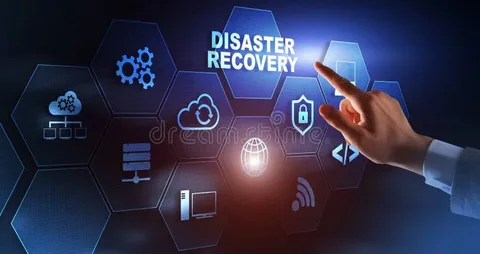In today’s unpredictable world, businesses are increasingly at risk from natural disasters, cyberattacks, hardware failures, and human errors. No matter how big or small, every organization relies heavily on its data, systems, and infrastructure. The sudden loss or disruption of these resources can be disastrous, impacting operations, revenue, and reputation. This is where a disaster recovery plan becomes crucial.
A disaster recovery (DR) plan outlines the procedures and strategies that an organization must follow to recover from disruptions and ensure the continuity of critical services. However, creating an effective DR plan requires expertise and resources, which is why businesses often turn to disaster recovery services to ensure a streamlined and robust strategy. In this article, we’ll explore the importance of a disaster recovery plan and the services that can help businesses navigate these challenges.
Understanding the Importance of a Disaster Recovery Plan
Protecting Data Integrity
One of the most valuable assets for any business today is its data. Whether it’s customer information, financial records, intellectual property, or communications, losing this data can lead to irreparable damage. A disaster recovery plan focuses on ensuring that data is regularly backed up and can be restored quickly in the event of an emergency. The faster a business can recover its data, the less impact a disaster will have on its operations.
Minimizing Downtime
In the digital age, downtime can be catastrophic. For every minute a business is offline, it risks losing revenue, customer trust, and operational efficiency. A solid DR plan helps minimize downtime by identifying critical systems and outlining steps for quick recovery. This is particularly important for businesses that rely on e-commerce, cloud services, or remote work environments where even short disruptions can lead to significant losses.
Ensuring Business Continuity
Business continuity goes hand in hand with disaster recovery. A disaster recovery plan doesn’t just focus on recovering data or systems but ensures that the business can continue operating, even in the midst of a disaster. This may involve setting up temporary workspaces, redirecting operations, or leveraging cloud-based infrastructure to ensure that services remain available to customers and stakeholders.
Compliance and Legal Requirements
Certain industries, such as healthcare, finance, and government, are subject to strict regulatory requirements regarding data protection and disaster recovery. Not having a disaster recovery plan can result in compliance violations, financial penalties, and a damaged reputation. A disaster recovery plan ensures that businesses meet legal requirements, protect sensitive data, and remain compliant with industry standards.
Types of Disasters That Can Disrupt Business Operations
A disaster recovery plan should address various potential threats, including but not limited to:
-
Natural Disasters: Earthquakes, floods, fires, and hurricanes can damage physical infrastructure and disrupt operations.
-
Cybersecurity Breaches: Ransomware attacks, data breaches, and denial-of-service attacks can cripple an organization’s data and systems.
-
Hardware or Software Failures: Server malfunctions, hard drive crashes, or software bugs can lead to unplanned downtime.
-
Human Errors: Employees inadvertently deleting important data, misconfiguring systems, or falling victim to phishing scams can result in data loss or operational disruptions.
By understanding these threats, businesses can design a disaster recovery plan that addresses the most likely causes of disruptions and ensures a rapid response.
Key Components of a Disaster Recovery Plan
A comprehensive disaster recovery plan should include:
-
Data Backup and Recovery: A system for backing up critical data regularly, along with processes to restore this data quickly in case of a disaster.
-
Business Impact Analysis (BIA): This involves identifying the most critical business functions and determining how quickly they need to be restored to avoid significant harm.
-
Disaster Recovery Team: Appointing a team responsible for managing disaster recovery efforts, communicating with employees, and coordinating the recovery process.
-
Recovery Time Objectives (RTO): The maximum allowable downtime for business processes.
-
Recovery Point Objectives (RPO): The point in time to which data must be recovered to minimize loss.
-
Testing and Validation: Regularly testing the DR plan through simulations and exercises to ensure the plan is effective and up-to-date.
Disaster Recovery Services: A Helping Hand
Many businesses struggle to design, implement, and manage a disaster recovery plan on their own. This is where disaster recovery services come into play. These services provide expertise, tools, and resources to ensure that a business is adequately prepared for disruptions and can recover swiftly when the need arises.
1. Cloud-Based Disaster Recovery Services
Cloud-based disaster recovery services are increasingly popular because they offer flexibility, scalability, and cost-effectiveness. Cloud providers offer backup and data replication services, allowing businesses to store critical data in off-site locations. In the event of a disaster, businesses can quickly switch to cloud infrastructure, minimizing downtime and ensuring business continuity.
2. Managed Disaster Recovery Solutions
For businesses that don’t have dedicated IT teams, managed disaster recovery solutions provide an end-to-end approach. These services handle everything from system monitoring and backup to disaster recovery testing and incident response. By outsourcing DR responsibilities, businesses can focus on core operations while ensuring that they are prepared for any emergency.
3. Data Backup and Archiving Services
Data backup services are the foundation of any disaster recovery strategy. These services focus on securely backing up business data to prevent data loss. Providers offer a range of backup solutions, including on-premises, off-site, and cloud-based backups. Data archiving services also help businesses comply with regulatory requirements by securely storing data for long-term access.
4. Cybersecurity-Focused Disaster Recovery Services
With cyberattacks becoming more sophisticated, many disaster recovery providers now offer cybersecurity-specific recovery services. These services include malware detection, ransomware protection, and real-time monitoring to help businesses identify and mitigate threats before they result in a disaster. A strong DR plan now integrates cybersecurity into the recovery process to protect against evolving cyber threats.
5. Disaster Recovery as a Service (DRaaS)
Disaster Recovery as a Service (DRaaS) is an emerging service that allows businesses to outsource their entire disaster recovery plan. DRaaS providers offer replication, failover, and backup solutions for both physical and virtual environments. This service is ideal for businesses looking for a cost-effective and reliable disaster recovery solution without having to manage it themselves.
Conclusion
In conclusion, the need for a disaster recovery plan is no longer optional for businesses. The risks associated with data loss, cyberattacks, or system failures can have long-lasting impacts on a company’s operations, reputation, and revenue. Disaster recovery services offer invaluable support, helping businesses create, implement, and maintain comprehensive disaster recovery plans. By leveraging these services, businesses can protect their data, ensure business continuity, and stay compliant with industry regulations, all while minimizing the financial and operational risks associated with disasters.




